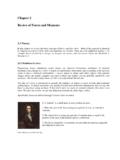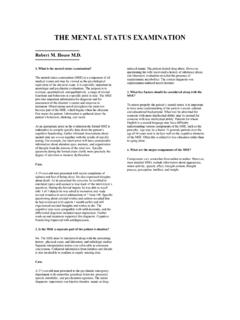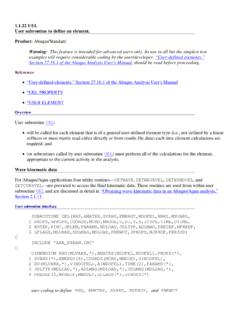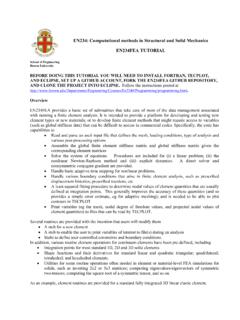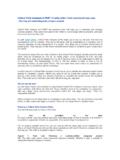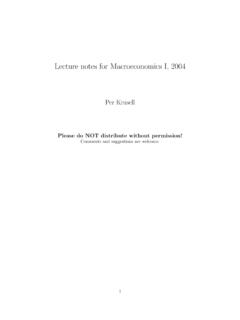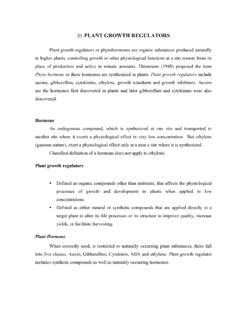Transcription of E000079 endogenous growth - Brown University
1 E000079endogenous growthEndogenous growth theory explains long-run growth as emanating fromeconomic activities that create new technological knowledge. This articlesketches the outlines of the theory, especially the Schumpeterian variety,and briefly describes how the theory has evolved in response to growth is long-run economic growth at a rate determined byforces that are internal to the economic system, particularly those forcesgoverning the opportunities and incentives to create technological the long run the rate of economic growth , as measured by the growthrate of output per person, depends on the growth rate of total factorproductivity (TFP), which is determined in turn by the rate of technologicalprogress.
2 The neoclassical growth theory of Solow (1956) and Swan (1956)assumes the rate of technological progress to be determined by a scientificprocess that is separate from, and independent of, economic theory thus implies that economists can take the long-rungrowth rate as given exogenously from outside the economic growth theory challenges this neoclassical view by proposingchannels through which the rate of technological progress, and hence thelong-run rate of economic growth , can be influenced by economic factors. Itstarts from the observation that technological progress takes place throughinnovations, in the form of new products, processes and markets, many ofwhich are the result of economic activities.
3 For example, because firms learnfrom experience how to produce more efficiently, a higher pace of economicactivity can raise the pace of process innovation by giving firms moreproduction experience. Also, because many innovations result from R&Dexpenditures undertaken by profit-seeking firms, economic policies withrespect to trade, competition, education, taxes and intellectual property caninfluence the rate of innovation by affecting the private costs and benefits ofdoing R& theoryThe first version of endogenous growth theory was AK theory, which did notmake an explicit distinction between capital accumulation and technologicalprogress. In effect it lumped together the physical and human capital whoseaccumulation is studied by neoclassical theory with the intellectual capitalthat is accumulated when innovations occur.
4 An early version of AK theorywas produced by Frankel (1962), who argued that the aggregate productionfunction can exhibit a constant or even increasing marginal product ofcapital. This is because, when firms accumulate more capital, some of thatincreased capital will be the intellectual capital that creates technologicalprogress, and this technological progress will offset the tendency for themarginal product of capital to the special case where the marginal product of capital is exactlyconstant, aggregate outputYis proportional to the aggregate stock of capitalK:Y AK 1 whereAis a positive constant. Hence the term AK theory .According to AK theory, an economy s long-run growth rate depends onits saving rate.
5 For example, if a fixed fractionsof output is saved and thereis a fixed rate of depreciationd, the rate of aggregate net investment is:dKdt sY dKwhich along with (1) implies that the growth rate is given by:g 1 YdYdt 1 KdKdt sA an increase in the saving rateswill lead to a permanently highergrowth (1986) produced a similar analysis with a more general productionstructure, under the assumption that saving is generated by intertemporalutility maximization instead of the fixed saving rate of Frankel. Lucas (1988)also produced a similar analysis focusing on human capital rather thanphysical capital; following Uzawa (1965) he explicitly assumed that humancapital and technological knowledge were one and the theoryAK theory was followed by a second wave of endogenous growth theory,generally known as innovation-based growth theory, which recognizes thatintellectual capital, the source of technological progress, is distinct fromphysical and human capital.
6 Physical and human capital are accumulatedthrough saving and schooling, but intellectual capital grows version of innovation-based theory was initiated by Romer (1990),who assumed that aggregate productivity is an increasing function of thedegree of product variety. In this theory, innovation causes productivitygrowth by creating new, but not necessarily improved, varieties of makes use of the Dixit Stiglitz Ethier production function, in which finaloutput is produced by labour and a continuum of intermediate products:Y L1 aZA0x i adi;0oao1 2 whereLis the aggregate supply of labour (assumed to be constant),x(i) is theflow input of intermediate producti, andAis the measure of differentintermediate products that are available for use.
7 Intuitively, an increase inproduct variety, as measured byA, raises productivity by allowing society tospread its intermediate production more thinly across a larger number ofactivities, each of which is subject to diminishing returns and hence exhibits ahigher average product when operated at a lower other version of innovation-based growth theory is the Schumpeter-ian theory developed by Aghion and Howitt (1992) and Grossman andHelpman (1991). (Early models were produced by Segerstrom, Anant andDinopoulos, 1990, and Corriveau, 1991). Schumpeterian theory focuses onquality-improving innovations that render old products obsolete, throughthe process that Schumpeter (1942) called creative destruction.
8 In Schumpeterian theory aggregate output is again produced by acontinuum of intermediate products, this time according to: endogenous growth2Y L1 aZ10A i 1 ax i adi, 3 where now there is a fixed measure of product variety, normalized to unity,and each intermediate productihas a separate productivity parameterA(i).Each sector is monopolized and produces its intermediate product with aconstant marginal cost of unity. The monopolist in sectorifaces a demandcurve given by the marginal product:a A i L=x i 1 aof that intermediateinput in the final sector. Equating marginal revenue (atime this marginalproduct) to the marginal cost of unity yields the monopolist s profit-maximizing intermediate output:x i xLA i wherex a2= 1 a.
9 Using this to substitute for eachx(i) in the productionfunction (3) yields the aggregate production function:Y yAL 4 wherey xa, and whereAis the average productivity parameter:A Z10A i in Schumpeterian theory create improved versions of oldproducts. An innovation in sectoriconsists of a new version whoseproductivity parameterA(i) exceeds that of the previous version by the fixedfactorg41. Suppose that the probability of an innovation arriving in sectoriover any short interval of lengthdtism dt. Then the growth rate ofA(i)isdA i Ai 1dt g 1 1dtwith probabilitym dt0with probability 1 m dt().Therefore the expected growth rate ofA(i) is:E g m g 1 . 5 The flow probabilitymof an innovation in any sector is proportional to thecurrent flow of productivity-adjusted R&D expenditures:m lR=A 6 whereRis the amount of final output spent on R&D, and where the divisionbyAtakes into account the force of increasing complexity.
10 That is, astechnology advances it becomes more complex, and hence society must makean ever-increasing expenditure on research and development just to keepinnovating at the same rate as follows from (4) that the growth rategof aggregate output is the growthrate of the average productivity parameterA. The law of large numbersguarantees thatgequals the expected growth rate (5) of each individualproductivity parameter. From this and (6) we have:g g 1 lR= this and (4) it follows that the growth rate depends on the fraction ofGDP spent on research and development,n R=Y, according to:g g 1 lyLn. 7 Thus, innovation-based theory implies that the way to grow rapidly is notto save a large fraction of output but to devote a large fraction of output toresearch and development.
